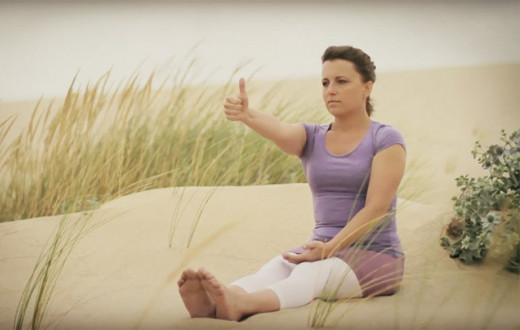By Sejal Shah I Posted : October 21, 2020
New to yoga? This beginner’s yoga Q & A guide will help you with the practice of yoga poses, breathwork, and meditation and also understand yogic philosophy.
Topics covered:
- What is yoga?
- Do I need to have a flexible body to practice yoga?
- How is the practice of yoga poses different from stretching or other fitness activities?
- What are the benefits of yoga?
- How old is yoga?
- What is the eight-fold path of yoga?
- What are the other paths of yoga?
- And how about so many different styles of yoga?
- Is yoga a religion?
- Do I need to be a vegetarian to practice yoga?
What is Yoga?
Yoga is an approach to health and wellbeing that promotes the harmonious collaboration of the human being's three components: body, mind, and spirit. It is uniting with the Self. The word yoga comes from the root word ‘yuj’ in Sanskrit, the language of ancient India. It means union, integration, or wholeness.
Yoga is a way of living and provides a complete philosophy to live a healthy, happy life to its full potential. Gurudev Sri Sri Ravi Shankar, the founder of Art of Living Foundation, says, “Like a flower bud, human life has the potential to blossom fully. Blossoming of human potential to fullness is yoga”.
Do I need to have a flexible body to practice yoga?
Yoga is for everyone and every body!
A male who practices yoga in a disciplined way and attains some level of progress is called a yogi, a female counterpart, a yogini. But the beauty of yoga is that yoga is for everyone. You don’t have to be a yogi or yogini to reap its many-fold benefits. Whether you are young or old, flexible or tight, overweight or slim, fit or unfit, regular practice of yoga strengthens the body and calms the mind. Contrary to popular belief, physical flexibility is neither the pre-requisite nor the goal to practice yoga. Let the intimidating postures not scare you and affect your enthusiasm to practice yoga!
How is the practice of yoga poses (asana) different from stretching or other fitness activities?
Unlike stretching, asana practice is more than physical fitness activity. The asana practice involves body-mind integration. While we do asanas, we connect the movement and stretching of the body to the rhythm of our breath and state of the mind. Integrating the mind, body, and breath helps us to direct our attention inward. This helps in turn to be more aware and in the present. There are no set goals to achieve anything. In fact, how much mental stuff we are able to let go and drop, that is what brings the depth to your practice. Your body is likely to become much more flexible by doing yoga poses. Along with that the mind will feel lighter and pleasant. Sri Sri Yoga Foundation Program offered by the Art of Living is a great platform to learn this integrated and holistic yoga practice.
What are the benefits of yoga?
Today, backed by scientific research, yoga has proven beneficial for people from all walks of life. Practitioners have experienced better physical health, improved figure, sustainable weight loss, a glowing complexion, relief from chronic pain and sickness, mental clarity, emotional stability, better intuition, stress relief, deep relaxation, and more creativity, energy, and enthusiasm for life. Yoga is also spiritually fulfilling and offers a feeling of deep connection and inner peace. Here are 13 top benefits of yoga for your body and mind explained in depth.
How old is yoga?
The origins of this ageless discipline lay in the deep inquiry and study by the sages of ancient India and it dates back to over 10,000 years. The in-depth study and meditative practices helped them reach a state of consciousness in which the mystery of a happier and meaningful living was revealed to them. The sages called this secret and sacred knowledge “Yoga”. Due to the oral tradition of imparting the knowledge, it was never chronicled until 5000 years ago. Around 400 CE Sage Patanjali is believed to have first collated the philosophy and practice of yoga into the Yoga Sutra. It consists of 196 aphorisms. Here is a video showcasing a brief history of yoga that can give you some more interesting facts about this ancient practice and philosophy.
What is the eight-fold path of yoga (or what are the eight limbs of yoga)?
The Patanjali Yoga Sutra serves as the guidebook for the most yoga practitioners even today. It outlines the famous eight limbs of yoga. These 8 limbs are —Yama (social ethics), Niyama (personal ethics), Asana (poses), Pranayama (breathing practices), Pratyahara (withdrawing the senses inward), Dharana (concentration), Dhyana (meditation), Samadhi (dissolving). This is called ashtanga yoga (ashta means eight, anga means limbs).
The five Yama and Niyama are like yoga’s guide on social and personal ethics. Practicing them in your daily life can transform you and your yoga practice.
Today, most people practicing yoga are engaged in the practice of the third limb, asana, which is a discipline of physical postures designed to purify the body and provide the physical stamina and strength. Many just relate and limit yoga to the practice of yoga postures. It is definitely a good starting point. But it is good to know that in ancient times, asana practice was meant more for cultivating the physical and mental stability and easiness that is required for the practice of meditation (the seventh limb). The literal meaning of asana is a seat.
Asana or yoga pose is simply an expression of mind-body integration. It is believed that there are more than 84,000 different yoga poses. Browse our detailed yoga poses catalog that gives information, instructions, and benefits of more than 50 most popular postures along with their English and Sanskrit names and also videos for sequences like subtle yoga (sukshma vyayam) and sun salutation. Here is also the list of 10 easy yoga poses for a beginner. Roll on your yoga mat, and enjoy twisting and stretching! If you are very new to yoga, these 14 tips will help you start off with the practice of yoga postures.
Though Sage Patanjali never mentioned any particular asanas in the yoga sutras, later scriptures like Hathayoga Pradipika, Gherand Samhita, and others mentioned a few names of asana, pranayama, and the six cleansing techniques known as shat kriya.
The word pranayama comes from two Sanskrit words — Prana (life force) and Ayama (control). So, in its broadest description, pranayama would mean the regulation, correction, and balance of the flow of life force, It is the science and art of breathing. Breath is the gross expression subtle life force energy. In recent years, the term breathwork has been coined to describe breathing techniques. Browse our full beginner’s guide on pranayama and give a try to some simple ones like Alternate nostril breathing or Ujjayi breathing. Beyond pranayama, learn the Art of Living’s signature breathwork—Sudarshan Kriya—at the SKY Breath Meditation course. To know more about it, join Beyond Breath - a free online introductory session.
Meditation is an ancient tool primarily for relaxing the mind and finding enlightenment. It has become the buzzword in modern times because of its manyfold benefits. Everyone seems to be interested in it. If you are new to meditation, our simple guide with 27 basic tips to get started with your meditation practice will help you a lot! There are many types and techniques of meditation, among those, I would recommend you to explore learning a simple and effortless meditation—Sahaj Samadhi.
What are the other paths of yoga?
Apart from the Patanjali Yoga Sutra, the Bhagavad Gita is one of the topmost original scriptures on yoga among many more. The different scriptures describe the deep philosophical and spiritual dimensions of yoga. They also explain different paths of yoga, like Gnan Yoga, Bhakti Yoga, Karma Yoga, Raja Yoga, Hatha Yoga. The Patanjali Yoga Sutra explained the eight-fold path of yoga as mentioned above. Just as all rivers lead to the same ocean, all paths of yoga have the potential to lead ultimately to self-realization and liberation.
And how about so many different styles of yoga?
Thanks to the global appeal of yoga, hundreds of different yoga styles have been developed by many different yoga teachers. Some popular ones offered in yoga studios are-Iyengar Yoga, Sri Sri Yoga, Vinyasa Yoga, Mysore Yoga, Ashtanga Yoga, Hatha Yoga, Restorative Yoga, Yin Yoga, Anusura Yoga, Jivamukti Yoga, Kundalini Yoga, Power Yoga, Hot Yoga or Bikram Yoga, and many other.
Sri Sri Yoga as inspired by Sri Sri Ravi Shankar is authentic Hatha Yoga practice. Sri Sri School of Yoga is a registered yoga school with Yoga Alliance and offers 200 Hour and 300 Hour teacher training programs.
Is yoga a religion?
Though yoga’s roots are in ancient India and connected to Hinduism, yoga has now become global phenomena and practiced by millions around the world irrespective of their faith or religious affiliation. In 2014, even the United Nations passed a resolution to celebrate 21st June as International Day of Yoga every year.
Do I need to be a vegetarian to practice yoga?
Like in yoga, belief in non-violence (ahimsa) is at the very heart of many religious and cultural traditions across the world. Even modern science supports and recommends a vegetarian diet. Though you don’t have to be a vegetarian to practice yoga, it is believed that a plant-based healthy, nutritious, wholesome diet complements very well with yoga practice and even deepens it. There is a long-standing debate about this in the yoga community and I believe that being vegetarian is a personal choice and decision. With yoga, you will definitely become more mindful of your eating habits and lifestyle.
Say your Om! And enjoy your stretching, twisting, turning, breathing, meditation, and yoga love!
In the meantime, if you want to practice guided breathwork and meditation, do join Beyond Breath - a free online session with a live instructor. You will also know more about SKY Breath Meditation.
Sejal Shah, E-RYT 500 Sri Sri Yoga Teacher, YACEP, C-IAYT, Meditation Teacher, Happiness expert, NYU Post Graduate Medical School approved Yoga-CME retreat facilitator, Mind-Body Wellness Writer, Homeopath. She can be followed on YouTube, Instagram, Twitter, and Facebook.





























